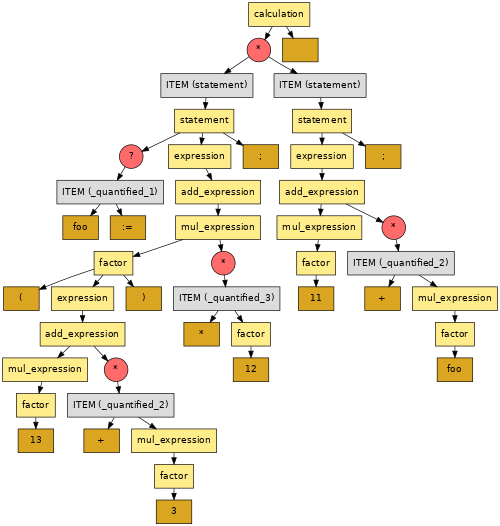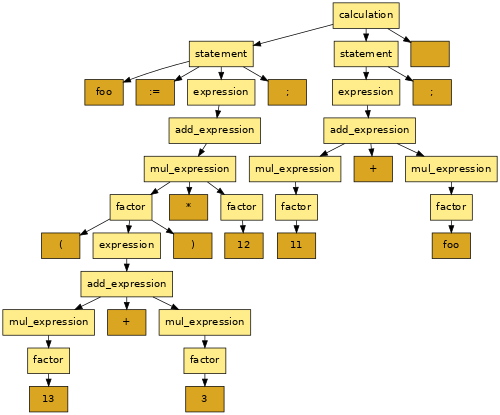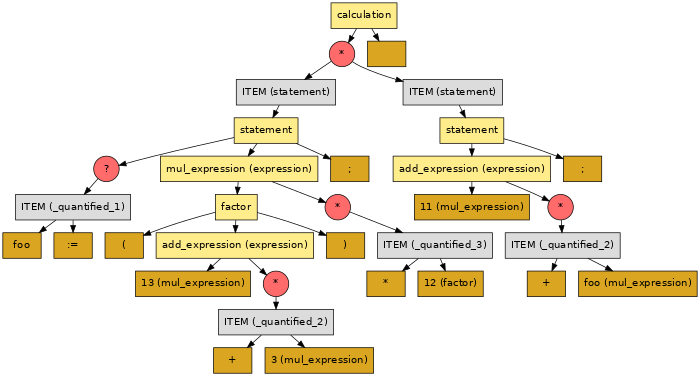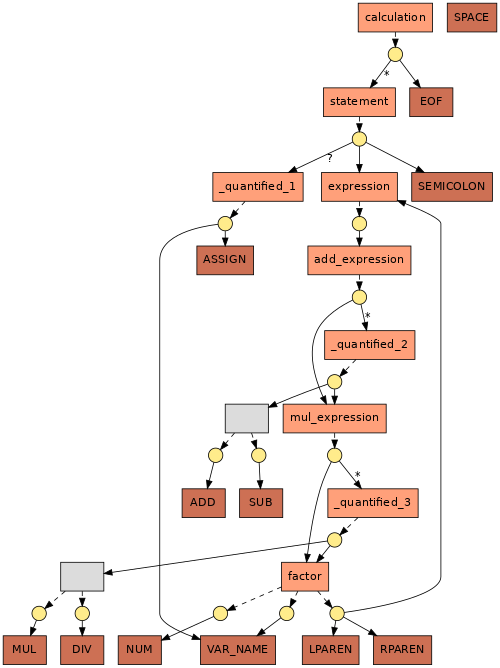The j-PEG Java library takes as input a Parsing Expression Grammar (PEG) and constructs an efficient packrat parser for it. The PEG can be either given in text form or constructed at runtime via API calls.
j-PEG has been designed with performance in mind and can parse even huge programs in complex languages in short time (we have successfully used j-PEG to parse fuzzer-generated programs with hundreds or even thousands of lines of code in real-world programming languages, including C, Lua, SQL, and SMT-LIB 2). It has been implemented as part of the RedPEG framework for test case reduction, but might be valuable for other use cases as well.
Note: j-PEG is part of a research project and should be considered a prototype rather than a ready-to-use PEG implementation; use with caution.
Please refer to the following publications for some background on PEGs and packrat parsers:
- Ford, B.: Parsing Expression Grammars: A Recognition-Based Syntactic Foundation. In: POPL’04: Principles of Programming Languages (Venice, Italy, Jan. 2004), 111–122.
- Ford, B.: Packrat Parsing: Simple, Powerful, Lazy, Linear Time. In: ICFP’02: International Conference on Functional Programming (Pittsburgh, PA, Oct. 2002), 36–47.
- Tratt, L.: Direct Left-Recursive Parsing Expression Grammars. Technical Report. School of Engineering and Information Sciences, Middlesex University (London, United Kingdom, Oct. 2010), 1-14.
Simply type ./gradlew build in the root directory of the j-PEG repository to build the j-PEG
library. After a successful build, there should be a file build/libs/j-PEG.jar. The instructions
below assume that this file exists.
Note:
- You need a working JDK installation to build and run j-PEG (tested with OpenJDK 8 and 11).
- Building j-PEG requires an internet connection to resolve external dependencies.
As indicated above, j-PEG has been designed with parsing performance in mind, which resulted in the following design decisions:
- In contrast to many other implementations, j-PEG strictly separates the lexer from the parser. This might reduce the flexibility a bit, but we found this to be fine for our use case.
- The parser uses packrat parsing (i.e., memoization; see the references above for more details). This way, its runtime is linear in the number of tokens in the input. Note, however, that the memoization might require a lot of memory and that j-PEG does currently not try to optimize the memory consumption.
- As it is known from parsing with classical context-free grammars (for details, please refer to a textbook on compiler construction of your choice), j-PEG computes the so-called first set for each rule in the given PEG. The constructed parser only tries to apply a rule if the next token in the input is included in the rule's first set. This reduces the number of (inevitably) failing attempts. In our experiments, this resulted in a considerably higher parsing performance.
Although j-PEG is meant to be used as a library in other projects, it also includes a simple
command line tool, which can be run with the run.sh helper script. This can be handy for examining
and validating PEGs. For example, run the following to print some statistics on the parser
performance (--parserStats) and the resulting syntax tree (--treeStats):
./run.sh \
--grammar example/calc_grammar.txt --in example/calc_input.txt \
--parserStats --treeStats
When using this command line interface, the following two options are always required:
--grammar: Path to the PEG that describes the syntax of the input.--in: Path to the input that should be parsed.
See the descriptions below for additional command line options.
Consider the following example PEG:
calculation: statement* EOF ;
statement: ( VAR_NAME ASSIGN )? expression SEMICOLON ;
expression: add_expression ;
add_expression: mul_expression ( ( ADD | SUB ) mul_expression )* ;
mul_expression: factor ( ( MUL | DIV ) factor )* ;
factor
: NUM
| VAR_NAME
| LPAREN expression RPAREN
;
ASSIGN: ':=';
SEMICOLON: ';';
ADD: '+';
SUB: '-';
MUL: '*';
DIV: '/';
LPAREN: '(';
RPAREN: ')';
@skip
SPACE: ( ' ' | '\n' | '\r' | '\t' )+ ;
NUM: '0' | ( [1-9][0-9]* ) ;
VAR_NAME: [a-zA-Z] [a-zA-Z0-9]* ;
This grammar matches programs of the following form:
foo := (13 + 3) * 12;
11 + foo;
The names of lexer rules consist of upper case letters (e.g., ASSIGN or SPACE).
The right hand side of a lexer rule consists of a single regular expression (please refer to the example above for the exact notation).
If a lexer rule is annotated with @skip (e.g., the SPACE rule from above), its matches are
discarded (i.e., its matches do not appear as tokens in the token stream).
The implicitly defined EOF rule matches the end of the input.
The names of parser rules consist of lower case letters (e.g., calculation or statement). The
first parser rule becomes the parser's start rule.
The right hand side of a parser rule uses a notation similar to that of EBNF:
*means zero or more repetitions+means one or more repetitions?means zero or one occurrences
Use the choice operator | to specify alternatives. Note: In contrast to "traditional"
context-free grammars in EBNF, the choice operator of PEGs is ordered. Thus, if the first
alternative matches, the second one is ignored. For example, a rule foo: A | A B; only ever
matches A tokens (but you can swap the alternatives so that the parser first tries to match A B).
Since the input PEG is converted to a recursive top-down parser, left recursive rules may lead to an infinite recursion. We provide experimental support for directly left recursive rules, but this has not been fully tested yet. Indirectly left recursive rules are currently not supported.
It is possible to annotate the rules for terminals and non-terminals in a PEG with one or more annotations, and these annotations might optionally carry an (integer or string) argument:
@some_annotation
foo: ... ;
@int_annotation(13)
@string_annotation("value")
bar: ... ;
Nodes in the syntax tree (see below) that belong to such an annotated definition carry these annotations (and their optional values) for further processing.
Some applications might require a way to specify weights for alternatives and quantifiers. Thus, these constructs can be annotated as follows:
foo
: <13> ...
| <3> ...
;
bar
: ( foo ) <3>*
;
It is up to the application to decide whether and how to use these weights.
A PEG can not only be specified with a textual grammar, but can also be constructed at runtime via
API calls. For this purpose, j-PEG offers the i2.act.peg.builder.GrammarBuilder class. The
implementation in i2.act.peg.main.CalculatorMain shows an example for how to use this class (which
can be run with the calculator.sh helper script).
In a nutshell, a PEG can be constructed at runtime by instantiating a GrammarBuilder and by
specifying grammar rules with its define() and declare() methods. The final PEG is then
constructed by calling the build() method on the GrammarBuilder.
Note: To simplify the specification of grammar rules, statically import the methods that the
GrammarBuilder class provides:
import static i2.act.peg.builder.GrammarBuilder.*;
This way, the statement rule from the example PEG above can simply be specified as follows:
builder.define(statement,
seq(opt(seq(VAR_NAME, ASSIGN)), expression, opt(SEMICOLON)));
If the input can be parsed according to the given PEG, j-PEG builds a syntax tree ready for further processing. In such a syntax tree, the inner nodes represent the rules of non-terminals that were applied during parsing, whereas the leave nodes represent the matched terminals (i.e., the tokens of the input).
By default, the syntax trees constructed by j-PEG contain quantifier nodes that represent matches
of quantified sub-rules; the children of such quantifier nodes are implicit ITEM nodes (this
ensures that each match of the quantified sub-rule is represented as a single sub-tree with a single
root node, even if the quantified sub-rule consists of multiple symbols). Thus, the default syntax
tree for the example language and input from above looks as follows:
Quantifier and ITEM nodes can be omitted by setting the respective parameter when constructing the
parser accordingly (when using the command line tool, add the --omitQuantifiers flag). In the
example, this results in the following syntax tree:
Syntax trees may contain long linear chains of nodes. j-PEG can optionally collapse such chains to single nodes to reduce the size of the syntax trees. In the example, this results in the following syntax tree:
To compactify a syntax tree, simply call the compactify() method on it (the command line tool
compactifies syntax trees by default; use the --noCompactify flag to disable the
compactification).
To not lose the information which non-terminal the root of a collapsed chain originally had,
compactified nodes store the original non-terminal as expected symbol (included in parantheses in
the image above), which can be retrieved with the method getExpectedSymbol().
For processing syntax trees, j-PEG offers the class i2.act.packrat.cst.visitors.TreeVisitor,
which allows the definition of a visitor that traverses a syntax tree and that executes specific
code for different nodes.
The implementation in i2.act.peg.main.CalculatorMain shows an example for how to define such a
visitor. In a nutshell, first construct a new instance of the TreeVisitor class. The type
parameters P and R specify the type of the (single) parameter of the visitor methods and their
return type, respectively. Then, (repeatedly) call the add() method on the newly created visitor
to register visit methods for the different symbols (i.e., terminals and non-terminals) of the
grammar. To run the visitor, call the visit() method and pass the syntax tree and the original
argument for the visit methods.
Some applications might need to further analyze a given PEG and j-PEG comes with some support for such analyses.
A given PEG induces a bi-partite graph, which j-PEG refers to as grammar graph and which it
represents as an instance of the class i2.act.grammargraph.GrammarGraph. Each nodes of such a
grammar graph is either a Choice (this includes all terminals and non-terminals of the grammar) or
a Sequence (which, as the name implies, represent sequences in the grammar). The edges from a
Choice to a Sequence are called Alternatives and the edges from a Sequence to a Choice are
called Elements (such Elements are annotated with the respective quantifier from the grammar, if
any).
For the example PEG from above, the grammar graph looks as follows (rectangular nodes are Choices
and circular nodes are Sequences):
To provide a common basis for different analyses of such grammar graphs, j-PEG includes the class
i2.act.grammargraph.properties.PropertyComputation. Currently, there is no example for such an
analysis in this repository, but the repository of the aforementioned
RedPEG framework contains several analyses (for example, the
RedPEG class i2.act.grammargraph.properties.SubsumptionComputation analyzes a PEG to find out
which non-terminals subsume which other terminals and non-terminals of the grammar).
j-PEG is licensed under the terms of the MIT license (see LICENSE.mit).
j-PEG makes use of the following open-source projects:
- Gradle (licensed under the terms of Apache License 2.0)



